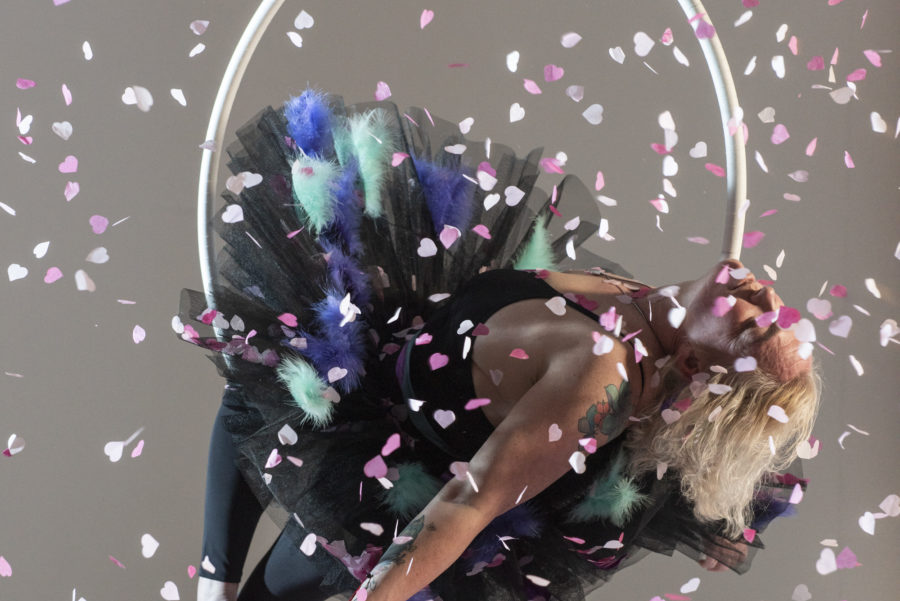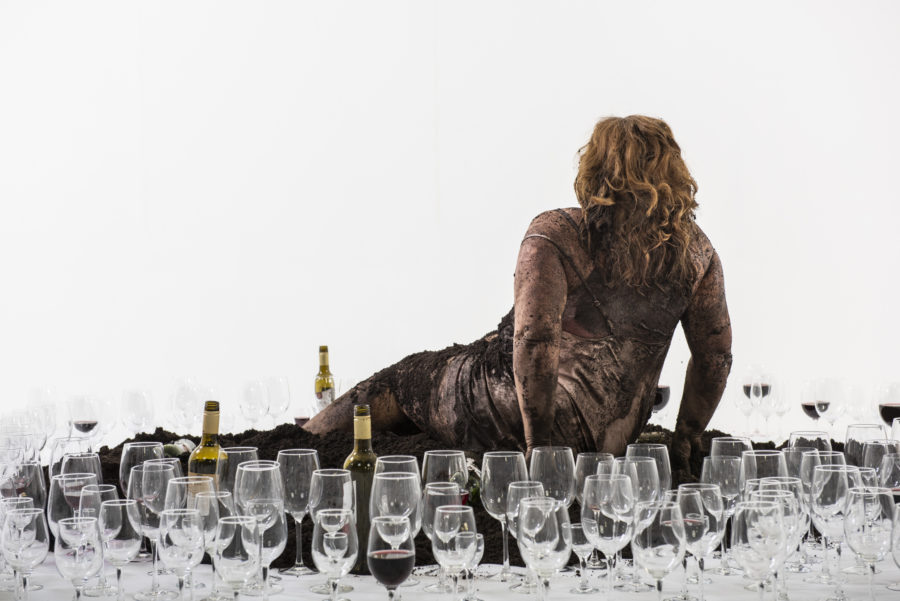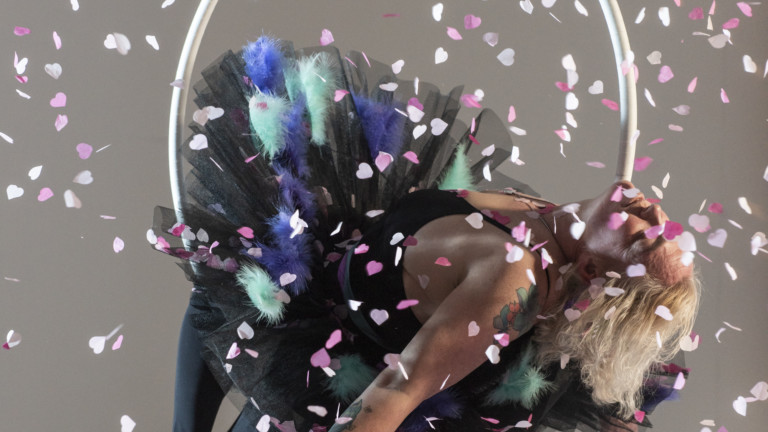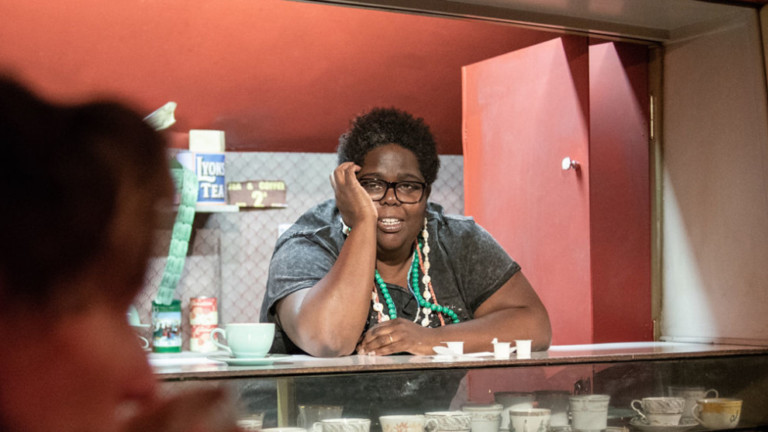Lyn Gardner speaks to artist Mark Storor on the making of the first part of 12 year project, The Suicide Chronicles.
A woman dressed in an over-sized man’s suit stands in a white space. Crockery hangs down from the ceiling. She raises a hammer, takes aim and smashes a plate. No saucer or teapot goes unscathed. The fragments spin in the air like jagged moons and stars. Another woman lies in the earth surrounded by glasses of wine; a third sits on an aerial hoop wearing a tutu in a shower of confetti.
These startling images come from The Suicide Chronicles, Chronicle One: Grief, three short films created by Joanne Lyne, Angela Samata and Lisa Vint together with the artist Mark Storor. They are part of a programme of work, produced by Heart of Glass, and co-created by Storor which, over a number of years and Chronicles, will create a creative vocabulary around the experience of suicide. Read more about the Suicide Chronicles project.
“ I am interested in making art that has real lived experience and everyday lives at its heart,” says Storor, “and these films are that, but they also offer a portal, a tool that helps people open up and talk so that they don’t feel so alone any more. Almost everyone I have met in St Helens has been touched by suicide in some way.”
St Helens in Merseyside has one of the highest rates of suicide in the UK. The films were shown in St Helens pre-Covid, in early November 2019 as part of a Madlove Take Over, a festival made with and for the people of St Helens.
Angela, Joanne and Lisa have all lost partners to suicide. But their individual experience of suicide is very different.



As Angela herself says: “grief is like a fingerprint: different for everyone but also something universal.”
The film in which she appears draws on a moment of emotion when she did indeed smash every dish in the kitchen following her husband’s death.
But one of the beauties of these exquisite co-created, co-authored works of art is that you don’t have to know the individual story behind each of the films to understand the emotions being expressed. One of Storor’s gifts is to take a very specific personal experience and make it touch us all. His generosity is that he allows himself to become entirely invisible within the work. The three films in Chronicle One offer another language in which each of the women can make sense of their experience and we who are watching can empathise and come closer to understanding what it is like to be bereaved by suicide.
“Working with the women over a long time is a way of creating a space where they could be as monstrous, vulnerable, angry and frustrated as they wanted to be without fearing they might hurt anybody else’s feelings,” says Storor.
It is important because there is still a stigma around suicide. Many of us can never find the words to speak about it. Chronicle One offers a rare public glimpse of a grief that often remains shut behind closed doors, leaving those living with grief isolated.
“The women are reclaiming something that was taken from them with their husbands’ deaths. They can’t ever reclaim their husbands, but they can take back their own feelings, own experience of grief,” says Mark Storor.
“Often in such circumstances other people try to define their grief for them, or they are very awkward in their presence or they are insensitive. But what each of the women have done in the films is take back control, frame their experience in a way that they want to do and say, ‘this is how it is for me.’”
The triptych forms an all too rare insight into the experience of grief. But suicide, its aftermath and ripple affect will be explored in many ways in the seven-string, multi-facetted project which looks outward beyond St Helens to other communities across the country and across the world, examining different experiences from teen suicide to the high rate of suicide amongst farmers.
“The Chronicles are not going to all be about St Helens, but rather exploring what St Helens has to say to other towns, other places and other countries, and what do they have to say to St Helens,” says Storor.
In the second Suicide Chronicle screening this week for invited audience, Storor working with professionals at the YMCA in St Helens looking at the experience of being on the front line of suicide. He is working with those who have discovered bodies and who are required to follow the procedures in place.
“How does that impact on that person and their own family life?” wonders Storor. “In this Chronicle we examine the procedures and protocols that the first responders have to follow. In the moment of encountering the dead the procedures in place don’t always seem appropriate, can seem brutal, and often don’t leave space to grieve or honour the person who has died, or the person who has found them.”
Each Chronicle will be made in its own right and own form as an individual work, but the depth and breadth and ambition of the project will only be truly apparent when all seven Chronicles finally come together. We think of nothing when artists like Robert Wilson or Robert Lepage are making work over a long period of time, and one of the radical things about the Suicide Chronicles is that it treats co-created work made about ordinary people’s lives with the same care, respect and artistic integrity and gives it the time it needs to grow.
“You have to both make this work with care and find ways to hold it with care too,” says Storor. “It needs to be valued as we value work made for the Royal Opera House and the National Theatre. My job is to make sure that it is the best it can be because the people I am working with deserve the very best.”




 Thought
Thought Long Read
Long Read